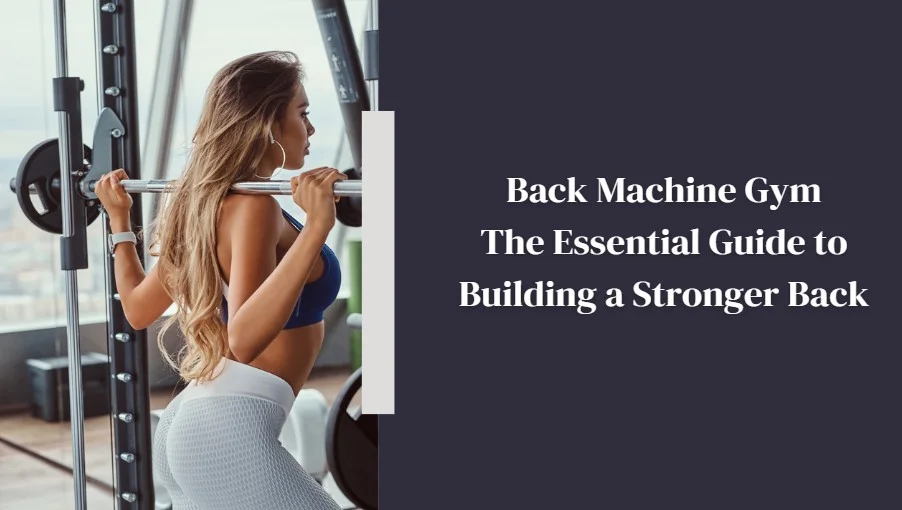Table of Contents
Introduction: The Backbone of Fitness
Amid the myriad of gym equipment targeting various muscle groups, back machines stand tall and significant. They’re not just apparatuses to pump up those back muscles; they symbolize the core strength and stability of the human body. In the world of fitness, where every machine has a purpose, back machine gym serve the quintessential role of fortifying our body’s foundation. The significance of a strong back goes beyond physical appearance. It’s an embodiment of health, a representation of endurance, and often a reflection of one’s commitment to a holistic and balanced fitness routine. In the evolutionary ladder, having a robust back was essential for survival, and in today’s modern era, it’s fundamental for good health and overall well-being.
The Science Behind Back Workouts
The human back isn’t just about aesthetics; it plays a pivotal role in our daily activities. Comprising an intricate network of muscles, tendons, and ligaments, our back supports posture, aids movement, and protects vital spinal structures. Engaging in regular back workouts is not a mere pursuit of broader shoulders or a V-shaped torso; it’s about ensuring that this network remains robust and resilient, safeguarding us from potential injuries and ailments. With the rise of sedentary lifestyles, many face back-related issues, from minor discomforts to debilitating conditions. Hence, understanding and respecting our back’s anatomy and physiology becomes paramount. It’s not just about looking good but feeling good and functioning optimally in everyday life.
Diving into the Types of Back Machine gym
Venture into any well-equipped back machine gym, and you’ll find an assortment of back machine gym equipment. From the classic lat pull-down and seated row machines to hyperextension benches and T-bar rows, the range is vast. Each back machine gym targets specific back muscles, be it the latissimus dorsi, the trapezius, or the erector spinae. Knowing which machine to use and when can dramatically impact one’s back training outcomes. For newcomers, this plethora of machines might seem overwhelming. However, with a little guidance, it becomes evident that each machine has its specific purpose, targeting various facets of the back. Hence, integrating a combination of these machines into one’s routine can lead to a well-rounded back workout, optimizing strength and flexibility.
The Multifaceted Benefits of Back Machines
While the primary objective remains muscle building, the advantages of using back machine gym extend far beyond. Improved posture, enhanced core strength, better functional mobility, and a reduced risk of back-related issues are some of the myriad benefits. Moreover, these machines provide a controlled environment, ensuring exercises are done with proper form, minimizing the risk of strains or sprains. But it’s not just about the physical benefits. A strong back can also boost one’s confidence, improve overall body mechanics, and contribute significantly to one’s quality of life. Whether you’re lifting groceries, playing with your kids, or engaging in recreational sports, a fortified back serves as the backbone of all these activities.
Dos and Don’ts with Back Machines
Like any gym equipment, back machine gym demands respect and understanding. It’s not merely about piling on weights and pulling or pushing. Proper form, understanding one’s limits, and gradual progression are the keys to harnessing the maximum benefits while avoiding potential pitfalls. This section delves into the essential guidelines to make the most of your back workouts. Ignoring these principles can lead to counterproductive results, or worse, injuries. It’s imperative to listen to one’s body, seek expert guidance when in doubt, and prioritize quality over quantity. After all, it’s not about how much you lift but how you lift that determines the efficacy of your back workout.
The Synergy with Other Workouts
A holistic fitness regimen is never about isolating a muscle group. Integrating back workouts with other exercises, be it legs, chest, or core, creates a harmonious balance. It’s this synergy that ensures overall strength, stability, and functionality. Dive into how back exercises complement and enhance other workouts, painting a holistic picture of fitness. In the grand orchestra of our body’s muscles, the back plays a foundational role. Just as a symphony relies on each instrument, our body relies on each muscle group working in harmony. Recognizing the interconnectedness of these muscle groups and tailoring workouts accordingly can lead to optimized results and a balanced physique.
Your Go-To Guide: World Gym San Diego Reviews
Conclusion: Embracing the Power of the Back
A strong back is not a mere reflection of physical prowess; it’s a testament to a healthy, functional, and balanced body. The back machine gym equipment plays a pivotal role in this journey, offering the tools and means to sculpt, strengthen, and stabilize our body’s foundation. As we continue our fitness journeys, let’s not overlook the significance of these machines and the monumental benefits they bring to the table.
FAQs: Answering the Back Machine Gym
Why is it Essential to Include Back Workouts in my Routine?
A well-balanced fitness routine necessitates back workouts to maintain posture, ensure overall muscle balance, and prevent potential back-related ailments.
Can I Solely Rely on Back Machine Gym for my Back Workout?
While back machines are effective, it’s beneficial to incorporate free weights and bodyweight exercises for a comprehensive back workout.
How often Should I Train my Back Using these Machines?
Typically, training the back 1-2 times a week is recommended, allowing adequate rest and recovery.
Are Back Machines Suitable for Beginners?
Yes, they offer controlled movements, making them ideal for beginners. However, proper guidance and starting with lighter weights are advised.
Do Back Machines also Benefit Older Adults?
Absolutely. They can aid in maintaining spinal health, improving posture, and counteracting age-related muscle loss.

